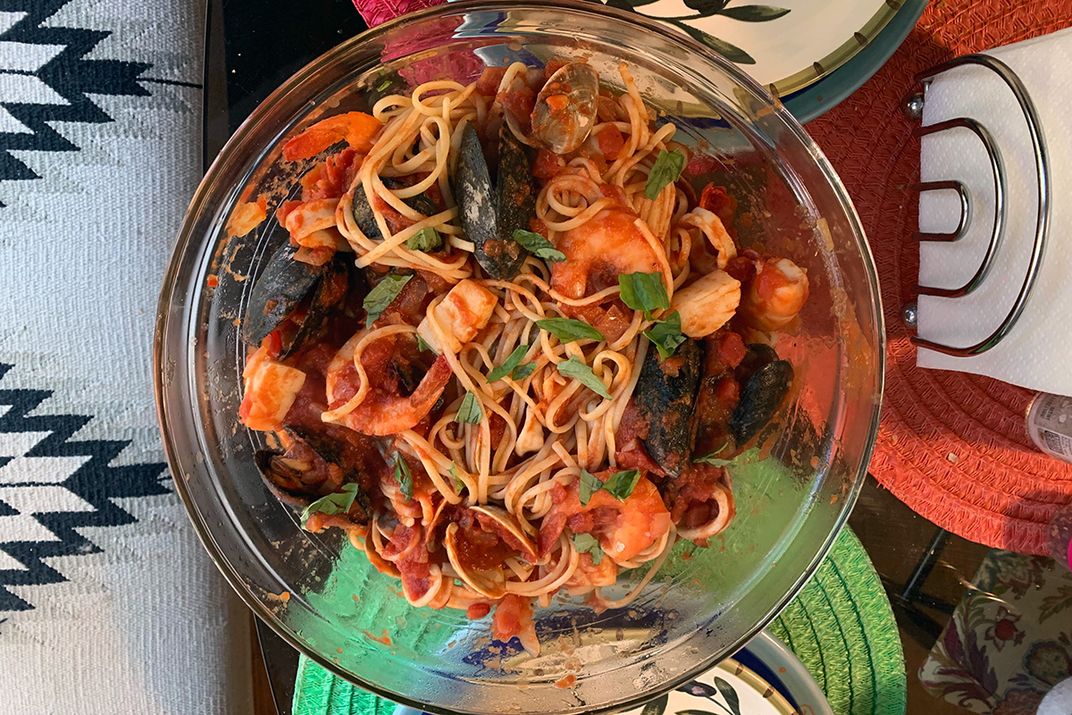SMITHSONIAN CENTER FOR FOLKLIFE & CULTURAL HERITAGE
Fra Diavolo Is a Devilish Dish for an Italian American Christmas
Fra diavolo is a spicy tomato sauce served over linguine and shellfish that roughly translates to “among the devil.
:focal(600x400:601x401)/https://tf-cmsv2-smithsonianmag-media.s3.amazonaws.com/filer_public/b5/45/b545b0c1-f095-4de5-b845-8e280aa609e2/fra-diavolo-3.jpeg)
Many Italian American families participate in the ritual of eating seven fishes on Christmas Eve. Traditionally this is done in seven small courses, each featuring a different type of fish. My grandmother cheats by instead making a giant pot of fra diavolo.
Fra diavolo is a spicy tomato sauce served over linguine and shellfish that roughly translates to “among the devil,” getting its name from the crushed red pepper that gives it its signature heat. It’s traditionally made with shrimp or lobster, sometimes accompanied by clams. I’ve yet to find another recipe that suggests you throw in the literal bounty of the sea that my grandmother does: shrimp, clams, mussels, scallops, and squid. It’s really more akin to frutti di mare. This covers five of the seven fishes in one dish.
My grandmother is not actually Italian; she was a Jewish girl who married into a Sicilian family. She learned how to cook these dishes from her mother-in-law and describes her own culinary expertise as spanning “from matzo balls to meatballs.”
She used to cook seven separate fish courses when she was a stay-at-home mom, but when she began working she had to scale things back. Her seafood pasta was a crowd pleaser—and covered most of the required fishes—so the main event of Christmas Eve became her modified fra diavolo. It’s spicy and salty, but not too rich or heavy to keep you from indulging in Christmas cookies after dinner.
In our house, the sixth fish is always an octopus salad, and the seventh is usually oysters. The seven fishes tradition is Southern Italian, and more Italian American than anything else. Most people in Italy have never even heard of it. The roots are unclear, but it’s believed to stem from the Roman Catholic practice of abstaining from meat on holy days. It’s likely a regional, coastal tradition that found roots in America among immigrants from all over the home country.
For the purposes of Catholic fasting, shellfish is considered fish, as is almost every other semi-aquatic organism. This leads to some strange loopholes, especially in places where fish is not readily available. Beavers spend most of their time in the water and are therefore seen as fish in the eyes of the Catholic Church, making them permissible to consume year-round. (You can thank a seventeenth-century bishop of Quebec for that one.)
There’s no consensus on why it’s seven. Some say it’s for the number of sacraments. Others serve different biblically significant numbers of fish. Many don’t keep count and just eat “lots of fish.” As a child, I was told if you ate all seven fishes you would have good luck in the New Year, though this may have just been a ploy to get me to eat as a picky little kid.
My grandmother has since retired from cooking big holiday meals, so my uncle has taken over fra diavolo duties (usually with her looking over his shoulder, nodding her approval). My grandfather makes the octopus salad, and whoever is hosting supplies the seventh fish.
I had to do a trial run of the dish before Christmas to verify a recipe for this article. (Like many grandmothers who cook, mine has neglected to write anything down.) It was my first time making it, and I’ve done my best to do it justice.

Fra Diavolo
Ingredients
2 tablespoons olive oil
1 large onion, diced
6 garlic cloves, minced
3 28 oz. cans crushed tomatoes
1/2 cup white wine
1 teaspoon dried oregano (1/2 tsp if using fresh)
Kosher salt
Freshly ground pepper
1 teaspoon sugar
1/2 teaspoon red pepper flakes (or more if you want it spicier)
12 ounces linguine (one box)
12 small clams, scrubbed
12 mussels, scrubbed
4 jumbo sea scallops
5 ounces baby squid (not tentacles, just the mantle)
8 large shrimp
Bunch fresh basil, torn
Parmesan, for serving
Preparation
Heat olive oil in a large, deep pot (a stock pot is great for this task). Add onions and stir, cooking until they begin to get translucent. Throw in garlic; cook a minute or two longer.
Add crushed tomatoes and stir, cook for a few minutes. Mix in wine, oregano, salt, pepper, sugar, and red pepper flakes. Let simmer for about 20 minutes, stirring occasionally. Use this time to prepare the pasta and seafood.
Prepare seafood: scrub mussels and clams under cold running water and discard any that are open or cracked. Cut scallops in half. Cut squid into rings if it came whole. Peel and devein shrimp if you prefer.
Bring a separate pot of water to a boil, salt generously, and throw in linguine. Cook until al dente. Drain and set aside. Add in a bit of the sauce to keep it from sticking together.
Taste sauce, season as needed. Then add seafood to the sauce in the following order:
Put the clams in first, and cook until they open. Do the same with the mussels. Once the mussels have opened, throw in scallops, stir, and let simmer a few minutes. Squid comes next. Cook until the rings become opaque and the edges start to curl slightly outward. The shrimp will cook quickly so it goes in last. It will turn white when cooked through.
Discard any clams or mussels that remain closed at this point.
Combine pasta, seafood, and sauce in a large bowl. Serve with basil and grated Parmesan. Provide bowls on the table for everyone to throw the shells in. Serves six.
Gabrielle Puglisi is a graduate of Emerson College and an intern at the Smithsonian Center for Folklife and Cultural Heritage.
